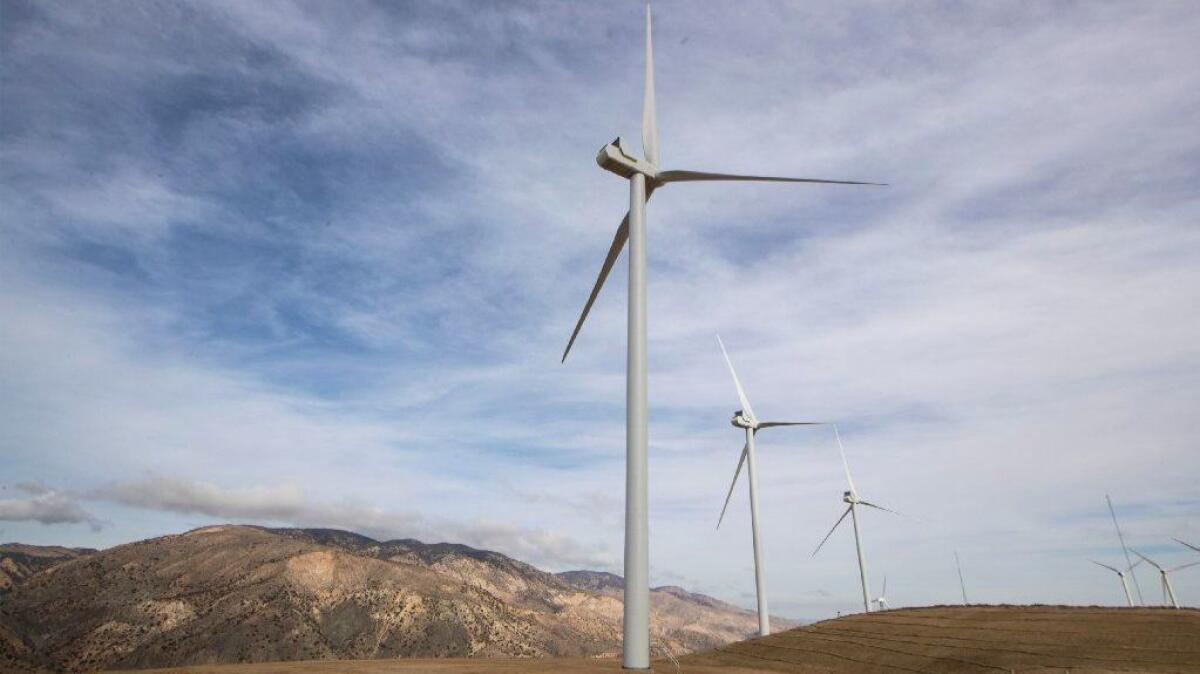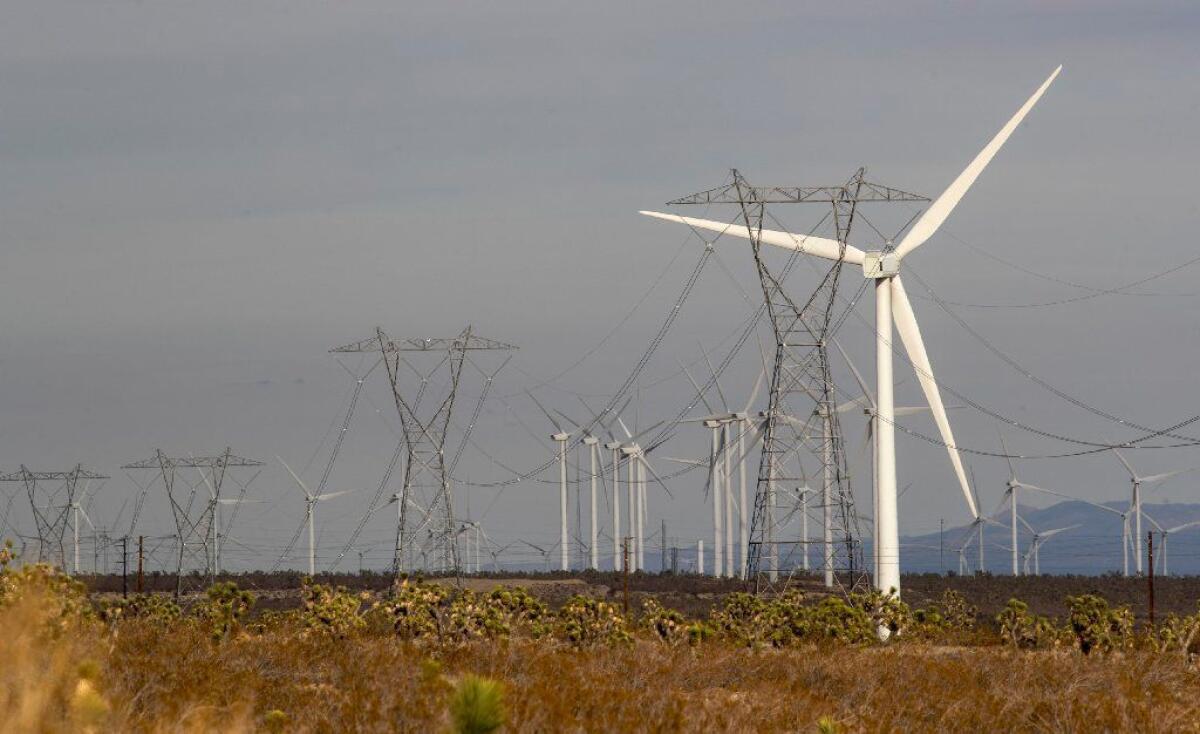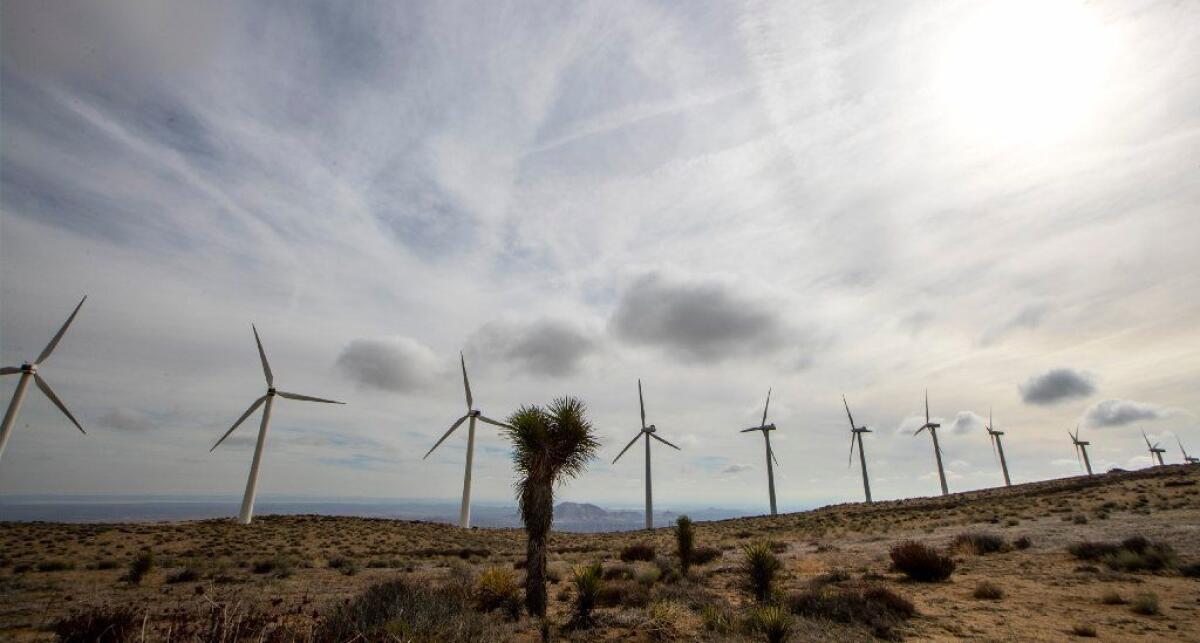Here’s how local governments are replacing California’s biggest utilities

Seventy miles north of downtown Los Angeles, where the Mojave Desert gives way to the San Joaquin Valley, three newly built wind turbines stand atop a ridge overlooking State Route 58. Strong gusts emerge from the mountain pass below, making this an especially windy spot in one of the windiest parts of California.
A few new turbines aren’t normally a big deal in the Golden State, which has been building wind farms for decades.
But these particular machines are at the heart of a revolution in California’s energy industry, which for millions of people, homes and businesses could mean an end to buying power from monopoly utilities such as Southern California Edison.
The three wind turbines at the top of the ridge — and three others nearby — recently started generating electricity for Clean Power Alliance, a government-run energy provider that is replacing Edison as the power source for more than 1 million homes and businesses across the Southland. Twenty-nine cities have joined Clean Power Alliance, as have unincorporated areas in Los Angeles and Ventura counties.
Residents of those areas will start receiving electricity from Clean Power Alliance in February. Edison will still distribute power over the poles and wires of the electric grid, and the Rosemead utility will send out the bills. But the alliance will buy and sell power, set rates and decide what incentives to provide customers for reducing their consumption or going solar.
Clean Power Alliance launched for a small group of customers last year, rolling out electric service to city governments and 30,000 businesses in parts of Los Angeles County. But next month will serve as the alliance’s grand opening. By the end of February, it will be California’s fifth-largest power provider, after Edison, Pacific Gas & Electric, San Diego Gas & Electric and the Los Angeles Department of Water and Power.
That fact is especially striking given Clean Power Alliance’s start-up-like working conditions. The alliance has 13 employees and is based in a WeWork shared-office space in downtown Los Angeles, with living-room-style lounges and Instagram-worthy neon lights.
“We’re not a bunch of people who were running some other public-sector something or other. We’re bringing a business savvy to this that is really important for our size and our ambition,” said Ted Bardacke, Clean Power Alliance’s executive director and a former infrastructure director for Los Angeles Mayor Eric Garcetti.
Clean Power Alliance customers can choose among three electricity rate plans: one with a 36% renewable energy mix that’s slightly cheaper than Edison’s base rate, one with 50% renewables that’s on par with Edison and one with 100% renewables that’s more expensive than Edison. They can also opt out of Clean Power Alliance service and return to Edison at any time.
Local governments across the state have been forming these so-called community choice aggregators, or CCAs, to reduce rates and increase the use of climate-friendly energy sources such as wind and solar.
The CCA push started in the Bay Area a decade ago and more recently spread to Southern California, where efforts are also underway to establish community choice programs in San Diego, Riverside County and other areas.
San Diego mayor calls for government alternative to SDG&E, says it’ll save ratepayers money »
Community choice providers are different from municipal utilities such as the DWP or Burbank Water and Power. Unlike municipal utilities, they’re not responsible for owning or operating the electric grid. Their role is to buy and sell the electrons that flow through power lines controlled by investor-owned utilities such as Edison.
Advocates say CCAs are an improvement on investor-owned utilities because they shift control from private monopolies to local governments, giving communities the ability to set their own rates, buy as much clean energy as they want and find creative ways to encourage clean energy technologies including rooftop solar, electric cars and microgrids.
There are now 19 community choice programs operating in California, 14 of which have launched in the last two years, according to the Center for Climate Protection, a nonprofit advocacy group.

What does community choice mean for clean energy?
Although CCAs are an increasingly popular option, the rapid expansion of community choice has caused some renewable energy developers to worry about potential unintended consequences.
California has tripled its use of renewable energy in the last 15 years, in large part by requiring utilities to replace fossil fuels with solar, wind and other renewable power sources. Most of the work has been done by Edison, PG&E and SDG&E, which serve about two-thirds of electricity demand statewide.
In 2017, Edison’s power supply was 32% renewable, PG&E’s was 33% and SDG&E’s was 44%, according to the California Public Utilities Commission.
The rise of community choice — and the loss of customers for the monopoly utilities — has fundamentally changed that model. State officials estimate that Edison, PG&E and SDG&E could lose 85% of their energy sales by the mid-2020s. With far fewer customers, they won’t need nearly as much clean electricity to meet the state’s upcoming targets of 60% renewable energy by 2030 and 100% climate-friendly energy by 2045.
California set a goal of 100% clean energy. Now other states may follow its lead »
Edison already has enough projects under contract or in development to meet the 2030 mandate, said Colin Cushnie, the company’s vice president of energy procurement and management. And with uncertainty over how many Edison customers will ultimately depart for CCAs, it’s not clear if or when the utility will sign more renewable energy contracts, which typically have a life span of 20 to 30 years.
“Since we’re meeting our statutory requirement,” Cushnie said, “we’re taking a hiatus at this point in time.”
Community choice providers are required to meet the state’s renewable energy targets too, and they’ve been picking up some of the slack as the monopoly utilities sign fewer contracts. Overall, CCAs have signed long-term deals for more than 2,000 megawatts of new renewable energy capacity, mostly solar and wind farms.
Clean Power Alliance’s six new wind turbines in Kern County are a small example.
“A lot of new steel has gone into the ground thanks to the CCAs,” said Don Vawter, director of origination and development for Terra-Gen, a New York-based energy developer that built the turbines for Clean Power Alliance.

But some renewable energy developers aren’t sure the CCAs can meet the state’s goals over the next few years. They say the newly formed entities don’t have credit ratings or much of a financial history, which can make it difficult to persuade lenders to fund construction of solar and wind farms.
The vast majority of the long-term clean energy contracts signed by CCAs so far have been inked by Marin Clean Energy and Sonoma Clean Power, the two community choice programs that have been around the longest.
“All the new ones that are being stood up today are struggling to figure out how they can obtain creditworthy status and contract for power,” said Bill Miller, an executive at Anschutz Corp., which has been working to build a huge wind farm in Wyoming and sell the electricity in California. “They can do some near-term, short-term contracts ... but to enter into long-term, reliable contracts is very difficult for them.”
Short-term contracts to buy clean electricity from existing projects can help CCAs meet their renewable energy goals for a few years. But in the long run, the state’s next climate change target — reducing carbon emissions 40% below 1990 levels by 2030 — will require huge amounts of new renewable energy capacity to be built.
The Large-Scale Solar Assn., a Sacramento-based trade group, estimated in September that CCAs needed to strike deals for an additional 5,000 megawatts of clean power by 2021 to meet the state’s long-term contracting requirements.
“There’s market uncertainty in terms of who’s going to buy, when are they going to buy,” said Rick Umoff, California director of state affairs for the Solar Energy Industries Assn., a national trade group. “It’s unclear if the CCAs are even equipped to buy the energy they need to meet the [renewable energy] targets.”
‘You have to figure out a way to get comfortable’
Community choice advocates say those concerns are overblown and don’t reflect the views of most renewable energy developers. They say the CCAs have met or exceeded the state’s clean energy targets so far and will continue to do so.
Nick Chaset, chief executive of East Bay Community Energy in Alameda County and a former chief of staff to California Public Utilities Commission President Michael J. Picker, noted that several of the country’s biggest clean energy developers, including NextEra and EDF, have done deals with CCAs. He said community choice programs have shown banks that customers will pay their bills and are unlikely to opt out of CCA service and return to the investor-owned utilities.
Chaset suggested that renewable energy trade groups skeptical of community choice were behind the times and haven’t caught up with the reality that their members are figuring out how to work with CCAs.
“They’re used to a certain system,” Chaset said, “and they’re struggling with the fact that the system is changing.”
It’s no longer just well-established CCAs that are signing long-term contracts. Silicon Valley Clean Energy and Monterey Bay Community Power, which launched in 2017 and 2018, respectively, have entered into three long-term contracts together, including deals with the developers Recurrent Energy and EDF for solar farms paired with battery storage.
The CCAs say those projects are the largest solar-plus-storage facilities ever contracted in California. Silicon Valley and Monterey Bay also signed a contract with Pattern Energy for 200 megawatts of wind power from New Mexico.
There are other examples of CCAs banding together to buy energy. Several CCAs have joined the Lancaster-based California Choice Energy Authority, which has negotiated contracts on behalf of its members.
Clean Power Alliance was able to get its first six wind turbines built because they’re part of a larger wind farm development, with more established buyers committed to buying most of the energy. But now the CCA is evaluating long-term contract offers from more than 50 developers, including proposals for solar, wind and battery storage.
The alliance might not have gotten so many offers a few years ago. But banks and energy companies are coming around on the CCAs, said Matt Langer, Clean Power Alliance’s chief operating officer and a former Edison employee.
“The developers have recognized that if you want to be developing renewable energy in California and the West, then who’s buying? It’s the CCAs,” Langer said. “So you have to figure out a way to get comfortable.”
More to Read
Inside the business of entertainment
The Wide Shot brings you news, analysis and insights on everything from streaming wars to production — and what it all means for the future.
You may occasionally receive promotional content from the Los Angeles Times.











